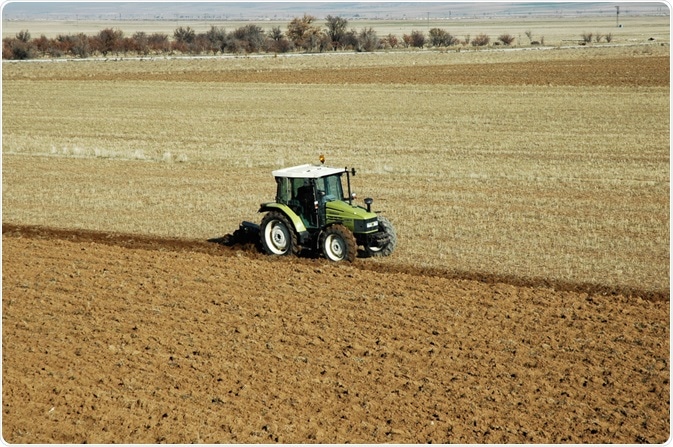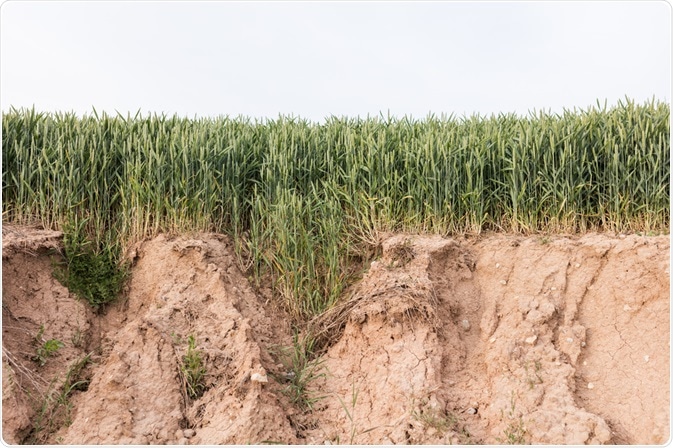The method of tillage has been employed by farmers for hundreds of years. First performed manually, by human workers, tillage was achieved by pulling plows through the field, or by using hoofed animals to trample the soil. Now, machinery is used to have the same effect of churning up the soil.

Image Credit: ompstock/Shutterstock.com
Tillage is a technique of manipulating the soil in preparation for crop production. The aim is to manage various characteristics of the soil, such as water retention, temperature, infiltration, and evapotranspiration.
Generally, tillage methods are classed as either primary or secondary. Primary tillage operations refer to methods that involve manipulation of the soil at deeper levels, whereas secondary is shallower.
Usually, primary tillage involves plowing and is the most intensive type of tillage. It occurs at the beginning of a new cropping season as farmers prepare their land to sow fresh seeds. Primary tillage operations that follow incorporate the use of field cultivators, harrows, tandem or off-set disks, and packers.
These processes are less intense and disturb the soil at lower levels than primary tillage, they are also usually selective of location. There is also a third category, known as tertiary tillage, which is not always utilized, but it occurs when the soil requires disruption during the phases of seeding, management, or harvesting.
Why do farmers use tillage methods?
There are several reasons for using tillage in agriculture. The main objective is to create grooves in the soil that are deep enough to successfully plant and grow crops. Other major objectives of tillage include aerating the soil, incorporating crop residues, and killing weeds.
Farmers use tillage to ensure the success of their crop yields and by not only promoting a preferable environment for seedling establishment but also by thoroughly incorporating fertilizers and herbicides into the land while controlling for weeds.
Primary tillage is mostly used for attaining soil depth, aerating soil, and killing weeds, whereas it is secondary tillage that is responsible for incorporating fertilizers and controlling for weeds.
There are several benefits related to tillage. Firstly, there is the obvious aeration and depth production which facilitate crop growth. Next, tillage also helps to mix organic matter and nutrients into the soil, enhancing its fertility and incorporating these nutrients into the crops.
Tillage also destroys the weeds that compete with these nutrients through its mechanical action. Before planting the seeds, it helps to dry the soil out, and in wintery weather secondary tillage helps to defrost the soil.
However, not all effects of tillage are beneficial, and a growing body of evidence is elucidating the drawbacks of the agricultural process.
How does tillage affect soil quality?
While one of the reasons farmers use tillage is to enhance the available nutrients in the soil, recent studies have shown that the process negatively impacts soil quality.

Image Credit: J. Lekavicius/Shutterstock.com
This is because the process of tillage fractures the soil, disrupting its structure. This leads to accelerated levels of surface runoff and also enhances soil erosion.
Increased surface runoff can be detrimental to farmers who live in environments that suffer from low rainfall because increased levels of runoff lower the water table, having the impact of intensifying the impact of droughts.
The churned-up soil also becomes vulnerable to the wind and rain which more easily blows and washes away the soil which no longer has a strong structure. Also, tillage removes crop residue which usually acts to protect the topsoil from the force of raindrops.
The result is that higher percentages of topsoil are removed, which lowers the quality of the soil, reducing its fertility, and also pollutes nearby bodies of water as the eroded soil deposits itself.
How does tillage impact global warming?
One major downside of using tillage techniques is that the process contributes to global warming. Usually, carbon dioxide is stored within the soil, but the process of churning it up has the impact of released this usually trapped carbon dioxide into the atmosphere, increasing greenhouse gas emissions.
If agriculture stopped using this method, the carbon would remain in the ground, and the emissions related to the agricultural sector would significantly decrease.
In the future, agriculture will likely move away from tillage techniques, using new technologies to continue to attain the benefits of tillage while avoiding the carbon emissions and damage to the soil that is related to the process.
New digital tools are currently being developed to help farmers control for weeds and knowledgeably add herbicides. It likely that alternatives to tillage will continue to be explored, currently researchers are investigating the benefits of non-tillage methods in growing a variety of crops.
According to recent data, more than a third of US cropland is utilizing no-till methods, a figure that is rising by around 1.5% annually. As concerns over global warming rise and people become more motivated to make changes it is expected that the use of alternative methods will accelerate.
Sources:
- Feng, J., Li, F., Zhou, X., Xu, C., Ji, L., Chen, Z. and Fang, F., 2018. Impact of agronomy practices on the effects of reduced tillage systems on CH4 and N2O emissions from agricultural fields: A global meta-analysis. PLOS ONE, 13(5), p.e0196703. https://www.ncbi.nlm.nih.gov/pmc/articles/PMC5962074/
- Haddaway, N., Hedlund, K., Jackson, L., Kätterer, T., Lugato, E., Thomsen, I., Jørgensen, H. and Isberg, P., 2017. How does tillage intensity affect soil organic carbon? A systematic review. Environmental Evidence, 6(1). environmentalevidencejournal.biomedcentral.com/.../s13750-017-0108-9
- Lobb, D., 2008. Soil Movement by Tillage and Other Agricultural Activities. Encyclopedia of Ecology, pp.3295-3303. https://www.sciencedirect.com/science/article/pii/B9780080454054008326
Further Reading
Last Updated: Apr 17, 2020